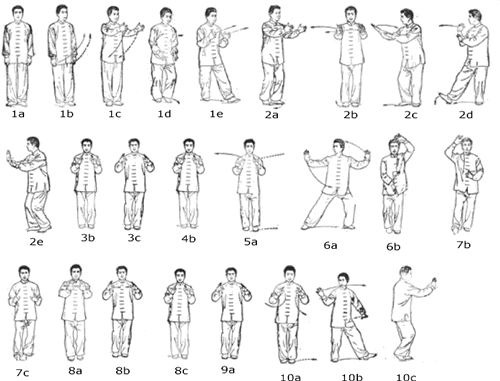Sun Style 38 steps
Video's van Sun style
De Sun-stijl is de laatst ontwikkelde stijl binnen Tai Chi. Sun Lu Tang ging in de leer bij Hao Wei Chen die de stijl van zijn voorgangers beoefende.
Opvallend binnen deze stijl zijn de natuurlijke standen, rechtop staande houding en voeten op schouderbreedte. Arm- en beenbewegingen ondersteunen elkaar en het accent ligt op het openen en
sluiten van de handen.
Links mbt Sun Style Tai Chi
Paragraaf 1 (16 bewegingen) in woord en beeld
* Info afkomstig van www.egreenway.com
1. Wu Ji Becomes Tai Ji
(Wu Ji Bian Tai Ji) 无极变太极
Name: Commencing Form (Qi Shi : 起式), Wu Ji then Tai Ji, Standing in Wuji and Opening Move, Commencing Form of Taiji (Taiji Qi Shi), A Study of Wu Ji and Tai Ji. 无极变太极 : Wu Ji Bian Tai Ji : Wu Ji Becomes Tai Chi.
Begin at position 1a, with the waist facing N12. Relax (Sung), clear the mind, calm the spirit, be present here and now. Stand at attention with the arms at the sides (1a). The heels are touching and the toes are pointed outwards slightly, so that the feet make a V shape (1a). The crown of the head is lifted. The shoulders are relaxed. Root and center oneself. This (1a) is the position of Wuji.
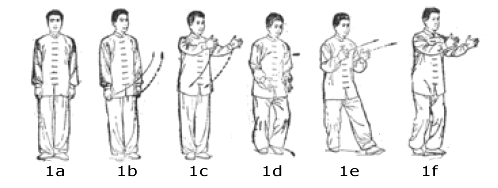
Description of movement sequence: Turn the right toe inward, and turn body towards NW11 (1a-1b). Raise the hands up with the fingers pointing down (1b). As as the hands move to about chest height (1b-1c) the fingers point forward (1c). Draw the hands in towards the body, and lower the hands to the Dan Tien level (1c-1d). Bend the knees slightly (1c). Lift both arms up, keeping them close to the body, to about chest height with the finders pointing forward (1d-1e). Shift the weight into the right leg (1d-1e) and step forward towards NW11 with the left foot, heel first (1d-1e) Draw the right toe forward until the right toe is next to and behind the left (1f). As the right leg moves forward, push both hands forward towards NW11 (1e-1f). The waist and chest face in the direction of NW11.
The movement sequence from 1d-1f, stepping forward with one leg and then following with the other leg is common in Sun Taijiquan. It is referred to as "Step and Follow Step" or "Follow Step." The first leg steps and the heel is placed first. The second leg steps with the toe. The knees are slightly bend. The torso is upright and poised. The back toe is placed so that it touches the ground next to and slightly behind the front foot, back toe near front heel. The knees are slightly bent.
Most authorities identify position 1a with "Commencing Form" and with Movement #1. Most authorities combine the movements 1b-1f with 2a-2e and call them all "Lazily Tying Clothes" (1b-2e), or Movement #2. I differ from the authorities about what constitutes movements #1 and #2.
I call positions 1a-1f, Movement #1, and give its name as "Wu Ji Becomes Tai Ji." In my opinion, position 1a represents Wu Ji: the empty state, the primordial fecund condition, that which cannot be named, the undifferentiated, Oneness, before the Big Bang, Zero, outside space and time, motionlessness, Wu. The body rises up and the hands circle up and down in positions 1b-1d, the typical opening move of raising the hands and lowering the hands of nearly all taijiquan forms, which represents: the opening, the differentiation into Yin and Yang, creation, emergence, the creation of complimentary forces, the essential beginning of space/time/being, Beginnings, the Grand Ultimate, the definitions of limits, the Tai Ji. The rising up and stepping forward and pushing forward (1d-1f) represent: the power of the universe, the five elements, the Bagua, the I Ching, complexity, evolution, the emergence of the ten-thousand things, will and intention, saying "Yes" to life, and the assertion of spirit. This is why I call this sequence (1a-1f) of movements "Wu Ji Becomes Tai Ji." I also think that this opening movement, Movement #1, Wu Ji Becomes Tai Ji, coordinates and blends well with the final two movements of the 73 Form, that is, Movement #72, Uniting Yin and Yang, and Movement #73, Returning to Wu Ji. This is how I interpret this sequence of moves, and this lifts my spirits. I find it charming and meaningful. Knowing of Sun Lu Tang's penchant for Taoist philosophy, I think he might smile and have some sympathy with my fanciful ideas. If you like, of course, you may also think that these movements (1b-1f) represent or are called or are part of "Lazily Tying the Clothes" (1b-1e). Indeed, I am probably just lazily trying to tie some ideas around the body of a dance.
"Creation and reversion are both expressed in Taiji quan forms. Practitioners begin by standing motionless and being free of thought [1a], then move in symbolic separation of yin and yang, lifting the hands as yang energy rises to create Heaven [1b] and lowering them [1d] as yin energy sinks to create Earth. Like the creation of the myriad beings, the movements transform from posture to posture without pause. In the end, the hands drop and the feet come together [72b]. Practitioners find stillness and return to formlessness [73c]."
- Daoist Body Cultivation, Edited by Livia Kohn, 2006, p. 195.
2. Lazily Tying Clothes
(Lan Zha Yi) 懶扎衣
Name: Tuck in Robes (Lan Zha Yi), Leisurely Tying Clothes, Lazily Tying Back the Clothes, Lazily Tying Clothes : Lan Zha Yi : 懶扎衣.
Position 2a = 1f. Many authorities say that the movement sequence of 1b-2e is all part of Lazily Tying Clothes. However, other instances of Lazily Tying Clothes in the 73 Form, namely Movements 18, 26, and 45, all look rather like 2a-2e with the addition of drawing the hands down before striking with the fingers (26b-26d), then circling back and to the side and then striking forward with the palm along with a follow step (26d-26f) or (2c-2e).
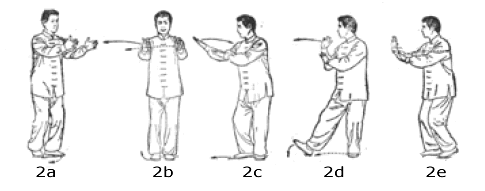
Description of movement sequence: From position 2a = 1f, rotate the arms at chest height in a clockwise manner towards the right side (2a-2c). The arms circle in a clockwise manner at chest height from left to right about 240° (2a-2c). Pivot on the left heel, then step back slightly with the right foot (2b) and position the right foot with toes facing E3. The left fingers touch the forearm of the right hand (2c). The right hand faces up, and left hand faces down (2c). The right hand makes a small clockwise inward circle and is drawn to the chest (2c-2d). Step forward with the right leg, heel first, and place the right foot facing E3 (2c-2d). As the weight moves into the right leg, the right hand moves forward, fingers up, towards E3 (2d-2e). Follow step with the left toe (2d-2e). The movement from 2d-2e is one continuous and coordinated movement with right hand moving forward as the left foot follow steps. At position 2d, the waist is facing E3.
Slide Show of Sun Lu Tang Performing the Sun 97 Taijiquan Form.
3. Opening Hands
(Kai Shou) 开手
Name: Open Hands (开手 : Kai Shou), Opening Hands.
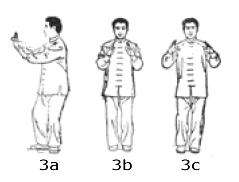
From 3a = 2e, turn the body to the left, 90° counterclockwise, to bring the front of the body to face N12 (3b). Move both hands to the left and bring the hands in front of body at chest height (3a-3b). Turn the right foot on the heel until both feet are facing N12 (3a-3b). Fingers are pointing up (3b). Palms face each other (3b). The hands are relaxed and the fingers are gently spread apart, and the thumbs point towards one another and are held about 2 inches apart (3b). Exhale gently through the nose while moving from 3a to 3b. The hands move from the side position (3a) until the hands are about shoulder width apart (3b), and then gently move towards each other (3b) until both hands hands are separated by about 6-8 inches or about the width of your head (3b). From position 3b, as you breathe in through the nose, gently and slowly move the hands apart (3b-3c). Keep the fingers pointing up and palms facing each other. Stop opening the hands when they are about shoulder width apart (3c). Keep your body standing tall, back straight. The knees are slightly bent. At position 3c, the waist is facing N12.
Moving from 3b to 3c is the act of "Opening Hands" (Kai Shou) and is an essential qigong move of Sun Taijiquan, and part of the essential transitional move between postures of the Sun Taijiquan Form.
Sun Lu Tang says, "The hands feel as if they are holding on to a balloon, and as the air in the balloon increases, the hands are slowly moved apart. The two thumbs are about an inch or two away from the chest. Move the hands apart until the tiger's mouth [i.e, the are from the inside tip of the index finger to the inside tip of the thumb] of each hand are in front of the shoulders, at shoulder height. The five fingers are separated. Pause for a moment." - A Study of Taijiquan, 1924, 2003, p. 81.
In photos of Sun Lu Tang in position 3e, his left heel is slightly raised; but other current 73 Form instructors have you keep both feet flat on the
floor in Opening Hands. Instructors vary in how much distance to keep between the feet when doing Opening and Closing Hands. Sun Lu Tang keeps his feet close together (3b), while
other instructors place the feet a comfortable distance apart (6" to 15").
Breathe in through the nose when opening hands. Stand up straight. Hold the head erect (3b-3c). Shoulders are slightly rounded inward. Knees are slightly bent. Relax and
settle; find the central equilibrium.
In Taijiquan, the complimentary concepts of "Opening" and "Closing," and their experiential correlates, are quite complex. Master Bruce Frantzis (Tai Chi Health for Life, 2006, pp.213-251) is a good source for starting to learn about these more advanced concepts in Tai Chi Chuan. Specifically, as related to opening and closing (pp.238-243), "Opening means to expand, grow larger, or flow outwards and emanate like a sun. Closing means to condense inwards, and get smaller along an inward direction of motion, like the gravity flow of a black hole or dwarf star. Closing carries no connotation of tension, contraction, or force in the movement, only a continuous inward flow toward a point of origination, like iron filings towards a magnet. Opening and closing actions can occur with any of the body's soft and hard physical tissues. Equally, opening and closing can occur anywhere within the body's subtle energy anatomy (channels, points, aura, etc.)."
4. Closing Hands
(He Shou) 合手
Name: Close Hands (合手 : He Shou), Closing Hands, Draw Hands Together.
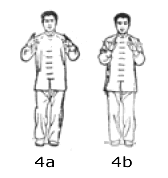
Move the hands from about shoulder width apart (4a = 3e) to about 6-8 inches apart (4b). This movement is called Closing Hands (He
Shou). Gently breathe out through the nose when closing hands (4a-4b). Stand up straight. Hold the head erect. Shoulders are slightly rounded inward.
Knees are slightly bent. Relax and settle; find the central equilibrium.
At position 4b, the waist is facing N12.
Moving from 4a to 4b is the act of "Closing Hands" (He Shou) and is the essential qigong move of Sun Taijiquan, and part of the essential transitional move between postures of the Sun Taijiquan Form.
In photos of Sun Lu Tang in position 4b, his left heel is slightly raised; but other current 73 Form instructors have you keep both feet flat on the floor in Closing Hands.
Sun Lu Tang says, "Lift the right toes off the ground and, pivoting on the right heel like an axle, turn your body to the left. As you turn, turn your right toes inward until they point directly forward. This turning movement must be done with the qi united, in one smooth movement without pauses or breaks. The jing must be balanced; do not use brute force. As you turn, the two hands maintain the position as if holding a balloon, as they close back together. The hands close until the thumbs are about an inch apart. The palms of the hands are empty, and they maintain the position as if holding a ball. The legs are bent. The right sole is placed flat on the ground and the left heel is lifted, with the ball of the foot on the ground. There must not be the slightest use of force in the entire body."
- A Study of Taijiquan, 1924, 2003, p. 82.
The Opening Hands (Kai Shou) and Closing Hands (He Shou) movements are repeated 9 times in the 73 Form at # 3/4, 8/9, 15/16, 19/20, 27/28, 42/43, 46/47, 51/52, and 63/64.
"Sun Shi Tai Ji has a very specific figure; Kai He (to open - to close) which is found neither in other forms of Tai Ji, nor in Ba Gua or Xing Yi. This Kai He appears with each connection and transition. It makes it possible to control and adjust breathing and to accumulate the Shi (energy potential) in order to prepare for the next change."
- Master Bob Melia, Sun Shi Tai Chi
5. Single Whip Left
(Dan Bian Zou) 单鞭左
Name: Single Whip Left (单鞭左 : Zou Dan Bian), Single Whip to the Left Side (Dan Bian Zhou), Single Whip.
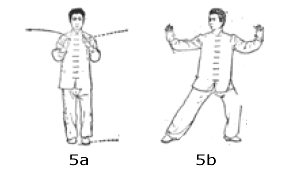
From position 4b = 5a, step out with left leg towards W9 (5a-5b). Open both of the the arms to sides, right hand towards E3 and left hand towards W9, with the fingers of both hands pointing upward (5a-5b). Look first at the left hand, then at the right hand (5b). Both arms are extended at about shoulder height (5b). End in 5b with left leg bent with 70% of weight in left left, in a left side bow stance. Gaze at the right hand (5b). At position 5b, the waist is facing N12.
In the Sun Style of Taijiquan, Single Whip always follows Opening Hands and Closing Hands (i.e., Movements 5, 21, 29, 48,53, and 65). In the Yang Style of Taijiquan, the Single Whip always follows the movement called "Grasping the Sparrow's Tail."
6. Lifting Hands
(Ti Shou) 提手
Name: Lift Hands and Step Up (Ti Shou Shang Shi); Lifting Hands (提手 : Ti Shou); Step In and Lift Hands; Raise Hands and Step Forward.
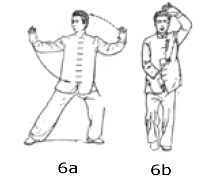
Step back to the right side towards W9 with the right foot, bringing it back next to the to the left foot (6a-6b) placing the right toe on the ground (6b). The right hand circles downward towards the waist (6a-6b). The left hand circles upwards (6a-6b) to a position slightly above the head with the palm facing towards N12 (6b). The right fingers point downward (6b), right thumb facing the Dan Tien, the right little finger facing forward. The left hand is about at forehead height, palm facing N12, left palm open (6b). At position 6b, the waist is facing N12.
7. White Swan Cools Its Wings
(Bai He Liang Chi) 白鹤凉翅
Name: White Crane Spreads Wings (白鹤凉翅 : Bai He Liang Chi); White Crane Flashing Its Wings: White Swan Cools Its Wings
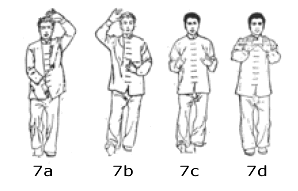
Slide the right hand up the body and raise it slightly above the head, with the palm facing forward towards N12 (7a-7b). The left hand moves from the forehead (7a = 6b) along the mid-line
of the body down to the waist (7b). Step forward with the right heel (7b-7c). Draw both hands to about chest height (7c) with the palms facing forward (7c). Push forward with
both hands, palms facing N12 (7d). Follow step with the left foot to a left toe stance with the left foot slightly behind the right heel (7d). At position 7d, the waist is facing
N12. Don't move the head up and down very much.
Sun Lu Tang says, "As the hands move, the right foot simultaneously steps forward, touching down on the heel. The feet should be spaced a comfortable distance apart. As you move the right foot forward, the body remains upright and stable. Do not move the body or shift the weight as the right leg moves. [This method of stepping (7b-7d) is constant throughout the form. Whether advancing, retreating, or stepping to the side, the foot steps out first, with no movement of the hips or torso, the heel is placed down, and then the body weight is gradually shifted to the stepping leg. One must never "fall" into the foot when stepping out.] The energy of the waist presses downward (7b). Use the intent to pull in the roots of the shoulders and legs. This energy must not be obvious externally. The pressing up of the crown of the head (7b) must not be obvious [i.e., using too much force or tension]. The center of the heart is empty and quiet. Without thought, the body is naturally stable. This is know as the wondrous mystery."
- Sun Lu Tang, A Study of Taijiquan, 1924, p. 85.
8. Opening Hands
(Kai Shou) 开手
Name: Open Hands (开手 : Kai Shou), Opening Hands.
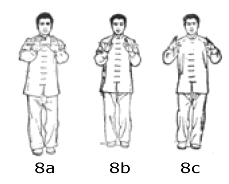
From 8a = 7d, draw the hands in towards the chest and turn the palms to face one another (8b). Move the hands together until they are about 6-8
inches apart, the width of your head, with the fingers facing up (8b). Exhale gently through the nose as you move from 7c - 8b. Inhale gently through the nose as the hands open to
about shoulder width (8b-8c). Stand up straight. Hold the head erect. Shoulders are slightly rounded inward. Knees are slightly bent. Relax and settle; find the central
equilibrium.
9. Closing Hands
(He Shou) 合手
Name: Close Hands (合手 : He Shou), Closing Hands.
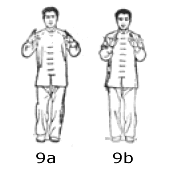
From position 9a = 8d, gently exhale as the hands move from about shoulder width (9a) to about 6-8 inches apart (9b), with the fingers facing up and the palms facing each other. The thumbs of both hands point towards each other and are about 2 inches apart. At position 9b, the waist is facing N12. Gaze forwards to N12.
10. Brush Left Knee and Twist Step
(Zuo Lou Xi Ao Bu) 左搂膝拗步
Name: Left Brush Knee and Twist Step (左搂膝拗步 : Zou Lou Xi Ao Bu); Twist Step (Ao Bu), Brush Knee (Lou Xi) and Palm Strike; Brush Left Knee and Twist Step.
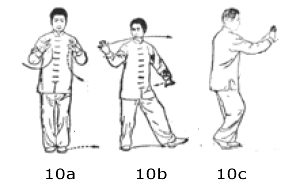
From position 10a = 9b, draw the right arm in a circle down and up to point to NE 10 as you turn the waist to the left side (10a-10b). The right hand is drawn up to about shoulder height (10b). Look at the right hand (10b). Step out with the left heel in the direction of W9. The left hand first moves so that the left fingers touch the right forearm as it moves towards NE10 (not shown in the illustration); then the left hand moves in a circle down and across the left thigh (10a-10b) - the classic "Brush Knee" movement. Turn the torso to the left as the right hand is draw at shoulder height past the face and in the direction of W9 (10b-10c). Follow step with the right foot by drawing the right toe to a position behind and to the side of the left foot (10c), as the right arm "Pushes" forward (10b-10c). The left hand ends beside the left thigh, palm facing down (10c). At position 10c, the waist is facing W9, and the eyes are looking in the direction of W9 (10c).
Section 1, Movements 1 - 10 This chart provides, for each movement, the number of the movement, the name of the movement, the final direction to face for each movement, a very brief description of the movement, and the summary chart (below) for movements 1-10. (PDF, 91 Kb, 2 Pages, 2008)
Sun Taijiquan 73 Form, Movements 1 - 10
Section 2, Movements 11 - 20
Sun Style Taijiquan, 73 Movements Standard International Competition Form
11. Hand Strums the Lute
(Shou Hui Pi Pa) 手挥琵琶
Name: Hand Strums the Lute (手挥琵琶 : Shou Hui Pi Pa), Playing the Pi Pa, Play the Lute, Play the Guitar.
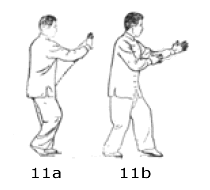
From position 11a = 10c, draw the right foot back towards E3 (11a-11b) and put more weight into the right foot. The left heel lifts so that only the left toe is on the ground (11b). Basically, assume a left empty stance (11b). As the right foot moves backward the left arm extends forward at about chest height with the fingers pointing forward (11b), and, at the same time, the right hand moves back towards the body and ends with the right fingers, pointing forward, near the left upper forearm near the elbow. At position 11b, the waist is facing W9.
12. Advance, Parry, and Punch
(Jin Bu Ban Lan Chui) 进步搬拦捶
Name: Advance, Parry and Punch (进步搬拦捶 : Jin Bu Ban Lan Chui); Advance Step, Deflect, Parry and Punch; Deflect, Parry and Punch.
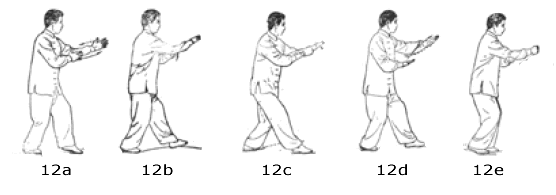
In this movement, we advance forward (12a-12e) towards W9 with four steps. At 12a = 11b, we begin by turning the left palm to face downward, and the right palm to face upward (12a). Step forward with the right foot (12b-12c), and the right hand moves forward and the hand turns over so that the palm faces down, and the left hand draws back into the waist and the left palm faces up. Then, step forward with the left leg (12c-12d), and the left hand moves forward with palm up, and the right hand moves backward towards the waist with the right palm turning down. As the weight settles into the left left, curl the left arm with palm facing inward at about chest height (12d-12e). Finally, punch forward with the right fist, thumb up, with right forearm finally resting on top of the left rounded arm. As the right punch is delivered the right foot follow steps to place the toe behind and at the side of the left heel (12e). At position 12e, the waist is facing W9. In the final stance the body should be upright, head up, knees bent.
Keep in mind we are practicing Huo Bu Sun Taijiquan - The Active Step Sun Taijiquan. This movement (12a-12e) is done rather quickly and smoothly, without any bouncing or jerkiness.
13. Apparent Close Up
(Ru Feng Si Bi) 如封似闭
Name: Apparent Close Up (如封似闭 : Ru Feng Si Bi); Appearing to Seal and Close; Withdraw and Seal.
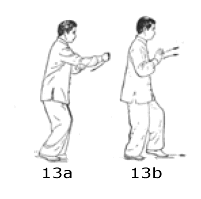
From the Punch position of 13a = 12e, separate both hands, bring hands to about chest height (13b), palms facing forward towards W9. Step back with the right foot and draw the elbows into the body (13b). Finally step back a half step with the left toe. Weight is in the back right leg. At position 13b, the waist is facing W9.
14. Carry Tiger and Push Mountain
(Bao Hu Tui Shan) 抱虎归山
Name: Carry Tiger and Push Mountain (抱虎归山 : Bao Hui Tui Shan); Embrace Tiger, Push Mountain; Push (An)
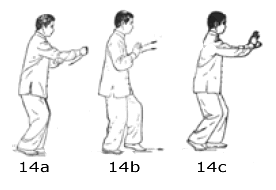
From the left toe stance of postion 14b = 13b, step forward a half step with the left foot (14b-14c). The both arms push forward, at about chest height, palms facing W9, as the back right foot follow steps forward to place the right toe next to the left heel. At position 14c, the waist is facing W9. 14a =12a and 14b = 13b. The body is held upright, head up, looking towards W9.
15. Opening Hands
(Kai Shou) 开手
Name: Open Hands (开手 :Kai Shou), Opening Hands.
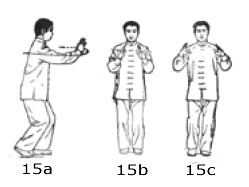
From 15a = 14c, turn clockwise to the right, pivoting on the right heel, and moving the left foot to the right (15a-15b). At position 8b, the waist is facing N12. The toes of both feet are on the same line. Exhale gently through the nose as you move from 15a-15b. There should be a comfortable distance between the two feet, but not too wide apart. Move the hands together until they are about 6-8 inches apart, the width of your head, with the fingers facing up (15b), thumbs about two inches apart. Inhale gently through the nose as the hands open to about shoulder width (15b-16c). Stand up straight. Hold the head erect. Shoulders are slightly rounded inward. Knees are slightly bent. Relax and settle; find the central equilibrium. At position 15c, the waist is facing N12.
16. Closing Hands
(He Shou) 合手
Name: Close Hands (合手 : He Shou), Closing Hands, Withdrawing Hands.
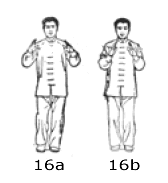
From position 16a = 15c, gently exhale as the hands move from about shoulder width (16a) to about 6-8 inches apart (16b), with the fingers facing up and the palms facing each other. The thumbs of both hands point towards each other and are about 2 inches apart (16b). At position 16b, the waist is facing N12.
Breathe out through the nose when closing hands. Stand up straight. Hold the head erect. Shoulders are slightly rounded inward. Knees are slightly bent. Relax and settle; find the central equilibrium.

